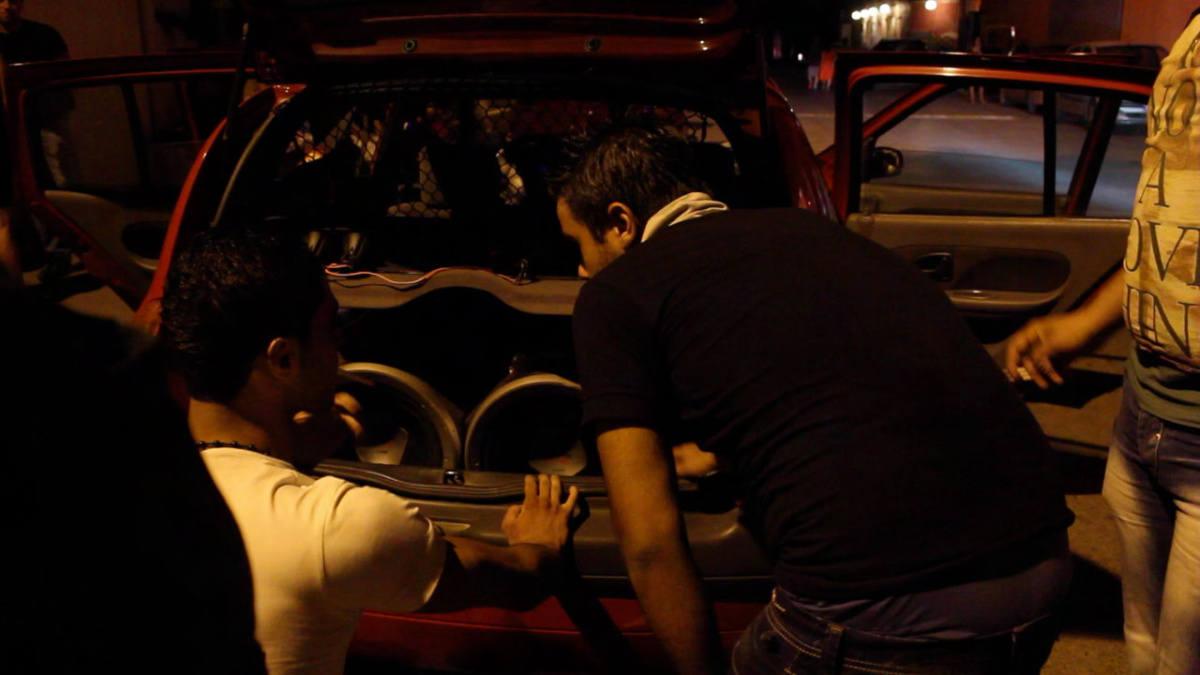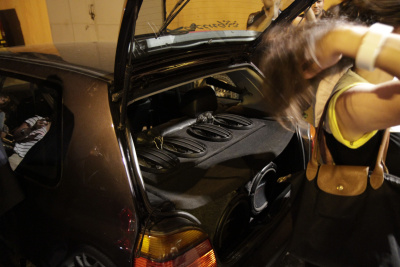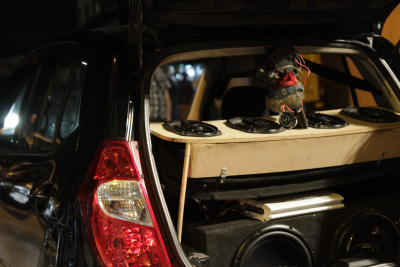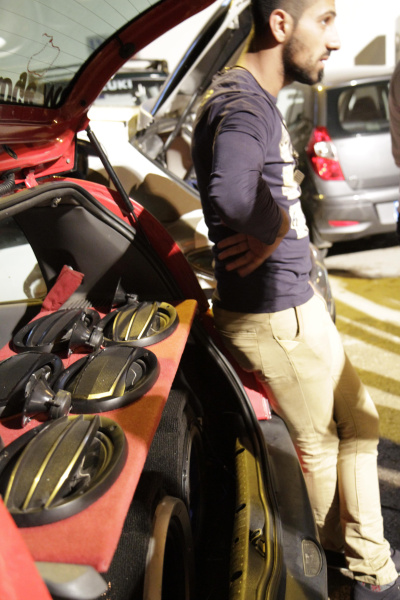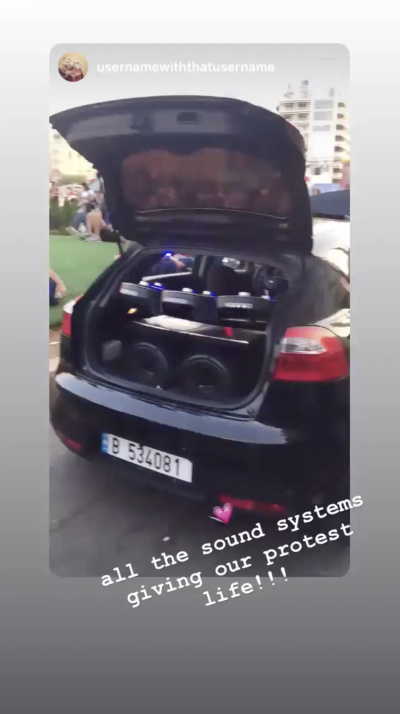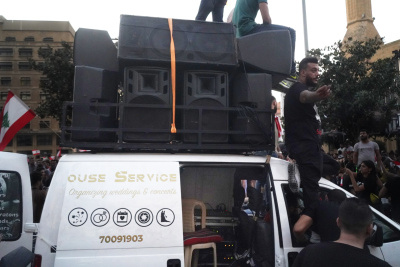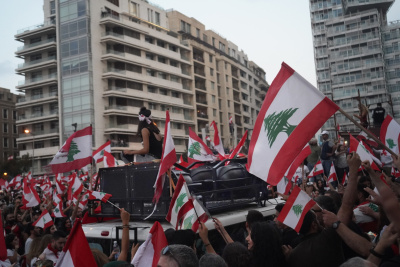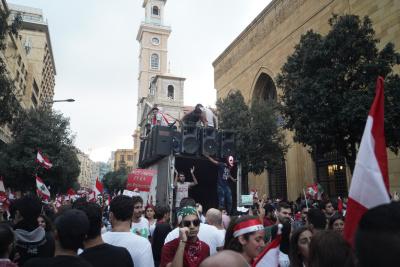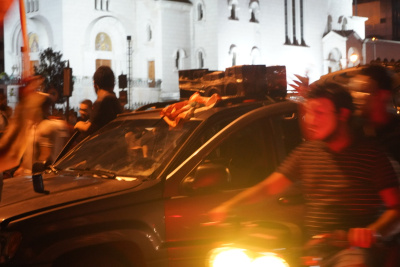Since 2012, artist Joe Namy has performed «Automobile», a variable channel sound performance for cars with super-modified stereo systems, in different cities around the world, starting with Beirut. In this essay, he explains the genesis of this performance and underscores the importance of bass and loud music, and the communities they help create.
«The Ghost of Dub, the ghost of sound systems in particular, that hiss that you’re hearing is connected with the sound from the beginning of the universe, it’s the cosmic microwave background. I think in a very physical scientific sense, what haunts dub, that hiss you hear, is the sound of the beginning of time.» – Eddie George, «Reflections on Dub and the Aesthetics of Noise» (2018)
A declaration of love, a conjuring, a call to dis-order, the low thumps that waft in passing from blocks away, are all of these. Heard before seen but immediately recognizable, distinct sound landmarks pronounce the prowl of the souped-up sound car in its element. These technological marvels of mobile sound are custom hand-built machines capable of producing bass so powerful it can shake the very concrete under your feet. Low frequencies are not just heard with our ears, we also listen with our skin, we listen from the gut. And although the subwoofer is a relatively new invention on the timeline of human sound manipulation, on the clock of the world of bass, sub-frequencies speak directly to our most primitive emotions. There is something fundamentally human about bass. It taps into our subconscious, resonates deep inside us.
Some people listen to music. Some people feel music. Some people feel music with dance, or in meditation, or in several parts of Beirut and Lebanon, through enormous subwoofers in the trunk of their car that pushes air so hard it can rock your core. This air is passion. This passion is bass, and the car is a getaway, a chase, an escape.
«Escapism has always been an adjective used to describe the dance. That’s an outsider’s view. Solidarity is what it really offers.» – Theo Parrish, Facebook post, 2016, written after the police killings of Alton Sterling and Philando Castile in Baton Rouge and St. Paul, USA.
In Beirut, cars line up along the seaside corniche, open their doors, and play music to the sea. Waves spill over distorted synths. Sea-salted shaabi music, techno, and hip hop mixes with shisha smoke and split sunflower seeds.
A ritual for bass:
trunks up,
windows down,
doors open,
volume up.
We performed this ritual on the street in front of Ashkal Alwan for Homeworks in 2012 and 2013. I put together an immersive sound performance entitled «Automobile», collaborating with young men and their cars whom we initially found in their element on the corniche, with the help of research assistant Jessika Khazrik. We selected cars based on their sound-system’s power, style, and passion. The men were invited to Ashkal to take part as performers, letting us use their cars to create a synced-up 11-car-speaker array connected to one controller, playing an 11-channel surround sound composition mixed live. Each system becomes a party on its own, and all together, a cacophonous congregation of bass in unison. In stereo automobiles ignite engines and speakers simultaneously.
The performance begins when the first car arrives and ends when the last car leaves. It’s a site-specific performance I’ve since put on in Mannheim, Gwangju, Toronto, Montreal, Abu Dhabi, and London. Every city has its own unique sound-car style, a rear view reflection of the streets these cars boom. In Canada, DIY bass cabinets are made with heavy wood frames while in Dubai, where timber is less accessible, they use shaped fiberglass curved with slopes of speakers.
The Social Structure of Open Trunks
Although speakers have only been around since the 1930s, and subwoofers since the 1960s, hi-tech bass is ancestral, tuned to resonate our blood. Shortly after speakers were invented, DJs were invented. Different types of music, such as dub and techno, were born from new technology and required new speaker sound designs, systems built to faithfully reproduce these new sounds. In Dahieh, a southern suburb of Beirut, a mechanic named «Ali Bazooka» builds his sound systems to be big, bulky, wires exposed bazookas, slang for powerful automobile speaker systems, designed for throwing amplified synthesizers playing distorted digitized folk songs. For these systems, fidelity is a spectrum, and often, the correlation between the recording quality of a song is inversely related to the emotional content – the grimier the bass the more raw the emotion.
«Roads are the infinity of things.» – Susan Stewart (1974)
On the open road, bass drifts, bass migrates. Music is to architecture, as dance is to music. If you listen to music in a car, the acoustics are indebted to the road, or the sea, or a gas station. In cars, we are somewhere, in music we are somewhere else. What we love about noise is the way we lose ourselves in it. What we love about the road is the way we lose ourselves on it, drifting noise, drifting self. This loss of self is actually a hyper-awareness, moving through feeling. Like any reality-bending experience, it can become addictive. For bass heads, thousands of dollars and countless hours of labor are spent on going lower and louder. An irrational economy of amplified expression. When you hear these systems on the street, the bass womps are actually a public display of affection and obsession. It’s an obsession that almost only afflicts young men.
«I am with you in the spirit of the Music whose resonance I would like to direct against the law.» – Fred Moten (1994, 51)
The young man leans on his sound car, the young man is transparent, the bass passes through him and obscures our view, we can only see the bass. The young man is invisible, to society, to politics, to be heard is to be seen, and bass is a voice, bass is our voice.
Much of what sound laws label as nuisance is how people audibly mark public space as «theirs». To some, these mobile sound systems are considered anti-social, uncivil, but to many of us, these are the sounds of life and community. They bring us together, providing a kind of public service, which announces cultural references, anthems, rhythms, voices that reinforce our sense of belonging to each other, and ultimately, to the sound of the beginning of the universe.
Because of this, sound cars served a deeper purpose during the protests of 2019. The different sound-systems that sprung up during the early days of the October 17 uprising played an essential role in the strategic cacophony. I counted at least 11 different sound-systems sprawled across Martyrs’ Square. Most of the sound-systems in the protest squares were literally a pile of speakers tied to the top of a van, fundamentally different from more conventional sound cars, but they all serve the same bass god. These systems played music, amplified speeches, and energized the crowd with call and response chants. Some had full-blown concerts with MCs balancing atop the speaker mounds, some recited poetry, and interspersed between the various systems were people with drums and megaphones, tear gas and burnt tires. More conventional sound cars also made an appearance, each sounding out wherever they could fit in. This is the roll of the ride, the sound car carves out space, claims the air and raises the vibration of the street.
